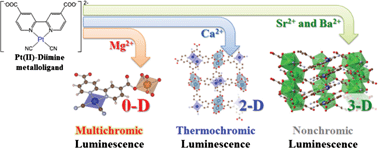Systematic structural control of multichromic platinum(ii)-diimine complexes ranging from ionic solid to coordination polymer†
Abstract
Reactions of a Pt(II)-diimine-based metalloligand Na2[Pt(CN)2(4,4′-dcbpy)] (4,4′-H2dcbpy =

* Corresponding authors
a
Division of Chemistry, Faculty of Science, Hokkaido University, North-10 West-8, Kita-ku, Sapporo, Japan
E-mail:
akoba@sci.hokudai.ac.jp, mkato@sci.hokudai.ac.jp
Fax: 81-11-706-3447
Tel: 81-11-706-3817
Reactions of a Pt(II)-diimine-based metalloligand Na2[Pt(CN)2(4,4′-dcbpy)] (4,4′-H2dcbpy =

 Please wait while we load your content...
Something went wrong. Try again?
Please wait while we load your content...
Something went wrong. Try again?
A. Kobayashi, H. Hara, T. Yonemura, H. Chang and M. Kato, Dalton Trans., 2012, 41, 1878 DOI: 10.1039/C1DT11155H
To request permission to reproduce material from this article, please go to the Copyright Clearance Center request page.
If you are an author contributing to an RSC publication, you do not need to request permission provided correct acknowledgement is given.
If you are the author of this article, you do not need to request permission to reproduce figures and diagrams provided correct acknowledgement is given. If you want to reproduce the whole article in a third-party publication (excluding your thesis/dissertation for which permission is not required) please go to the Copyright Clearance Center request page.
Read more about how to correctly acknowledge RSC content.
 Fetching data from CrossRef.
Fetching data from CrossRef.
This may take some time to load.
Loading related content
